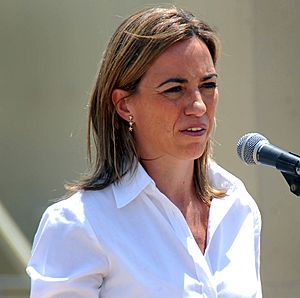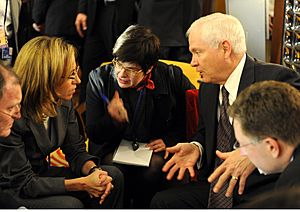Carme Chacón facts for kids
Quick facts for kids
Carme Chacón
|
|
|---|---|
 |
|
| Minister of Defence | |
| In office April 14, 2008 – May 20, 2008 |
|
| Prime Minister | José Luis Rodríguez Zapatero |
| Preceded by | José Antonio Alonso |
| Succeeded by | Alfredo Pérez Rubalcaba (interim) |
| In office June 30, 2008 – December 22, 2011 |
|
| Prime Minister | José Luis Rodríguez Zapatero |
| Preceded by | Alfredo Pérez Rubalcaba (interim) |
| Succeeded by | Pedro Morenés |
| Minister of Housing | |
| In office July 9, 2007 – April 11, 2008 |
|
| Prime Minister | José Luis Rodríguez Zapatero |
| Preceded by | María Antonia Trujillo |
| Succeeded by | Beatriz Corredor |
| Member of the Congress of Deputies | |
| In office January 13, 2016 – July 19, 2016 |
|
| Constituency | Barcelona |
| In office March 13, 2000 – August 31, 2013 |
|
| Constituency | Barcelona |
| Personal details | |
| Born |
Carme Chacón Piqueras
March 13, 1971 Esplugues de Llobregat, Spain |
| Died | April 9, 2017 (aged 46) Madrid, Spain |
| Political party | PSOE (PSC) |
| Spouse | Miguel Barroso (2007–2016) |
| Alma mater | University of Barcelona University of Kingston York University Laval University |
| Occupation | Lawyer Professor |
Carme Chacón (born March 13, 1971 – died April 9, 2017) was a Spanish politician. She was a lawyer and also taught at a university. Carme Chacón made history as Spain's Minister of Defence from 2008 to 2011. She served in the government led by Prime Minister José Luis Rodríguez Zapatero.
Chacón was a member of the Spanish Socialist Worker's Party (PSOE) since 1994. She was elected to the Parliament of Catalonia. She also became the vice president of the Congress of Deputies, which is like the lower house of the Spanish Parliament. Before becoming Minister of Defence, she was the Minister of Housing in 2007.
Contents
Early Life and Education
Carme Chacón was born in Esplugues de Llobregat, a town in Catalonia, Spain. She studied law at the University of Barcelona. After that, she continued her studies at other universities, including Kingston University and Université Laval in Canada.
From 1994 to 2004, she worked as a teacher. She taught constitutional law at the University of Girona.
Political Career
Carme Chacón joined the Socialists' Party of Catalonia (PSC) and the Spanish Socialist Workers' Party (PSOE) in 1994. Her political journey began when she was first elected to the Spanish Parliament in 2000. She represented the area of Barcelona.
Member of Parliament
Chacón started her career in parliament after the general elections in 2000. She won a seat representing Barcelona. She continued to be elected as a Member of Parliament in several elections after that.
Minister of Housing
During Prime Minister José Luis Rodríguez Zapatero's time in office, Carme Chacón became the Minister of Housing. She took over from María Antonia Trujillo. While she was in charge, she had to deal with a big challenge: the "Spanish real estate bubble." This was a time when housing prices were rising very quickly.
Minister of Defence
On April 14, 2008, Carme Chacón was named the Minister of Defence. This was a very important moment because she became the first woman to hold this position in Spain. What made it even more notable was that she was seven months pregnant at the time.
When she gave birth, another minister, Alfredo Pérez Rubalcaba, temporarily took over her duties. After her child was born, she decided to live in the Ministry's residence. This place had its own kindergarten, which helped her save time traveling to work. That year, surveys showed that people thought she was the most important minister in Prime Minister Zapatero's government.
In 2009, Carme Chacón announced a decision to remove Spanish troops from Kosovo. This was because Spain did not recognize Kosovo's independence. Even though the US government disagreed, Spain worked with its NATO allies to slowly bring these troops home.
That same year, there was a problem with piracy in waters near Somalia. Carme Chacón had to deal with the capture of a Spanish fishing boat called Alakrana by pirates. A year later, she explained why Spain was sending more troops to Afghanistan. She said there was hope for a good outcome there. A few months later, she visited Haiti to honor Spanish soldiers who died in a helicopter crash. She also visited troops who were helping after an earthquake.
At a NATO meeting in Lisbon in 2010, she announced that the Spanish Armed Forces would start handing over control of two Afghan provinces in 2011. This was three years earlier than NATO had planned. As Minister, she also declared a state of emergency in Spain during a crisis with air traffic controllers in 2010. She also led meetings for EU defence ministers when Spain was in charge of the European Union's rotating presidency. During this time, she helped negotiate extra funding for the Airbus A400M Atlas military transport plane.
In 2011, the Spanish Parliament passed a new law for soldiers' rights and duties. This law is sometimes called the "Chacon law." It allowed soldiers to form associations and created a committee to connect the Ministry with the troops.
Later Political Roles
After Prime Minister Zapatero decided not to run for re-election, Carme Chacón was expected to try to become the leader of her party. However, after the PSOE party did not do well in local elections in 2011, she decided not to run. She left her role as Minister of Defence and was replaced by Pedro Morenés.
In January 2012, she announced her plan to run for the general secretary of the PSOE. She wanted to "lead a new project" and "raise" the party. However, she lost the election to Alfredo Pérez Rubalcaba.
From July 2014, Carme Chacón was in charge of the Socialist party's international relations. She left politics in 2016 to work as a lawyer. She was also a member of the European Council on Foreign Relations.
Personal Life
From 2007 to 2016, Carme Chacón was married to Miguel Barroso, a Spanish journalist. They had a son, also named Miguel.
Carme Chacón passed away at her home on April 9, 2017, at the age of 46. She had a congenital heart defect, which means she was born with a heart condition. She suffered from dextrocardia (her heart was on the right side of her chest) and an atrioventricular block (a problem with her heart's electrical signals).
See also
 In Spanish: Carme Chacón para niños
In Spanish: Carme Chacón para niños



